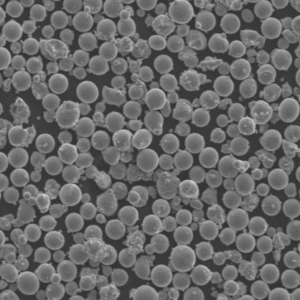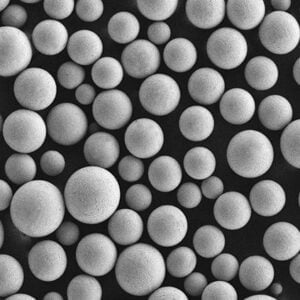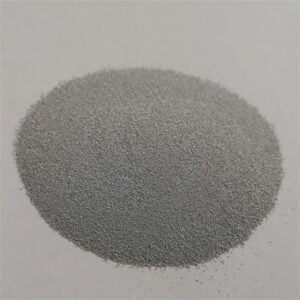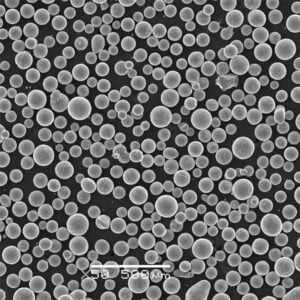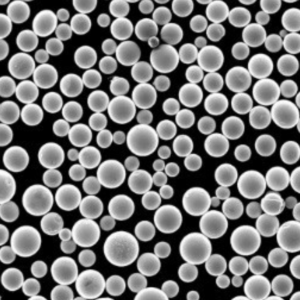가스 분무 금속 분말
목차
가스 분무 금속 분말 은 금속 사출 성형(MIM), 적층 제조, 프레스 및 소결, 용사 코팅, 분말 야금 등과 같은 응용 분야에 사용되는 미세한 구형 금속 분말을 생산하는 재료 가공 방법을 말합니다.
가스 분무에서는 고압 불활성 가스 분사를 사용하여 용융 금속 합금을 방울로 분해합니다. 액적은 빠르게 분말로 응고되어 분말 응고 공정에 이상적인 고도로 구형화된 형태를 생성합니다.
이 가이드에서는 가스 분무 금속 분말의 구성, 특성, 응용 분야, 사양, 생산 방법, 공급업체, 장단점 및 고려해야 할 FAQ를 다룹니다.
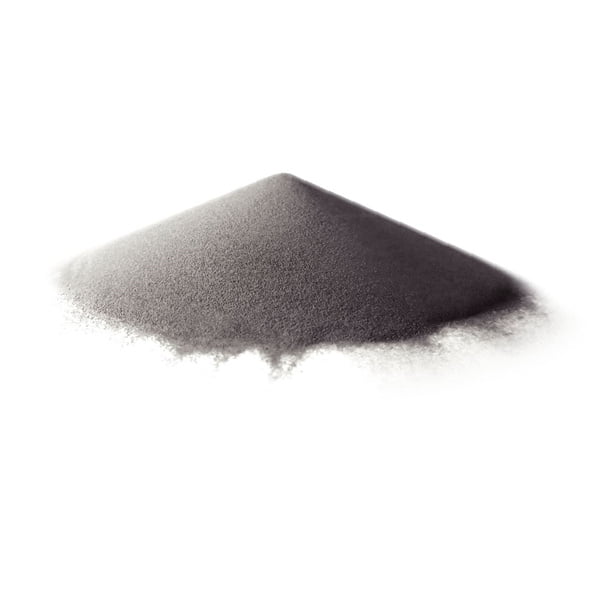
가스 분무 금속 분말의 구성
다양한 금속과 합금을 맞춤형 화학 물질로 분무하여 분말로 만듭니다:
| 재질 | 구성 개요 | 일반적인 합금 |
|---|---|---|
| 스테인리스 스틸 | Fe-Cr + Ni/Mn/Mo | 304, 316, 410, 420 |
| 공구강 | Fe-Cr-C + W/V/Mo 합금 | H13, M2, P20 |
| 알루미늄 합금 | Al + Cu/Mg/Mn/Si | 2024, 6061, 7075 |
| 티타늄 합금 | Ti + Al/V 합금 | Ti-6Al-4V |
| 니켈 합금 | Ni + Cr/Fe/Mo 합금 | 인코넬 625, 718 |
| 구리 합금 | Cu + Sn/Zn/합금 | 황동, 청동 |
이러한 금속 분말은 제조에 필요한 특정 기계적, 열적, 전기적 및 기타 물리적 특성을 제공합니다.
특성 가스 분무 금속 분말
화학적 특성 외에도 입자 크기, 모양, 밀도, 미세 구조와 같은 특성이 성능을 결정합니다:
| 속성 | 설명 | 고려 사항 |
|---|---|---|
| 입자 크기 분포 | 직경의 범위/분포 | 최소 피처 해상도, 패키징 효율성에 영향 |
| 파티클 모폴로지 | 파우더 모양/표면 구조 | 둥글고 부드러운 입자로 최상의 흐름과 핸들링 제공 |
| 겉보기 밀도 | 입자 간 공극을 포함한 부피당 무게 | 컴팩트성 및 클러스터링에 영향을 미침 |
| 탭 밀도 | 기계적 탭핑 후 정착 밀도 | 파우더 베드 다짐의 용이성 관련 |
| 표면 화학 | 표면 산화물, 잔류 가스 또는 습기 | 파우더 안정성 및 일관성에 영향을 미칩니다. |
| 마이크로 구조 | 입자 크기/상 분포 | 통합 후 경도, 연성 등의 물성을 결정합니다. |
이러한 상호 연결된 측면은 필요에 따라 균형을 이룹니다.
가스 분무 금속 분말의 응용 분야
일관된 재료 입력 및 네트 성형 기능은 다양한 애플리케이션을 지원합니다:
| 산업 | 용도 | 컴포넌트 예제 |
|---|---|---|
| 적층 제조 | 3D 프린팅 공급 원료 | 항공우주 에어포일, 의료용 임플란트 |
| 금속 사출 성형 | 작고 복잡한 금속 부품 | 노즐, 기어, 패스너 |
| 누르고 소결 | P/M 컴포넌트 생산 | 자동차 구조 부품, 군사/총기 부품 |
| 열 스프레이 | 표면 코팅 | 마모 방지, 부식 방지 오버레이 |
| 분말 야금 | 오일라이트 베어링, 자체 윤활 부싱 | 다공성 구조의 마모 부품 |
가스 분무는 최종 성능 요구 사항에 적합한 미세 구조와 화학 물질을 맞춤화할 수 있는 고유한 접근 방식을 제공합니다.
사양
애플리케이션에 따라 다르지만 일반적인 공칭 범위는 다음과 같습니다:
| 매개변수 | 일반적인 범위 | 테스트 방법 |
|---|---|---|
| 입자 크기 분포 | 10 - 250 μm | 레이저 회절, 체 |
| 파티클 모양 | >85% 구형 | 현미경 |
| 겉보기 밀도 | 2 - 5 g/cm3 | 홀 유량계 |
| 탭 밀도 | 3 - 8g/cm3 | 탭핑 볼륨계 |
| 잔류가스 | < 1000 ppm | 불활성 가스 분석 |
| 표면 산화물 함량 | < 1000 ppm | 불활성 가스 분석 |
더 타이트한 분포 곡선은 후속 프로세스에서 안정적인 성능을 보장합니다.
가스 분무 생산 개요
- 금속 잉곳, 폐 스크랩과 같은 원료로 유도로를 충전합니다.
- 용융 물질, 시료 화학 및 온도
- 용융 금속 스트림을 밀착 결합된 가스 분무기 노즐로 강제 분사합니다.
- 부드러운 액체 금속 흐름 모양 만들기
- 고속 불활성 가스 분사(N2, Ar)가 스트림을 물방울로 분해합니다.
- 금속 방울이 빠르게 응고되어 ~100-800 μm의 분말로 굳어짐
- 사이클론 분리기를 통해 거친 분획을 열적으로 분류합니다.
- 수거 시스템 및 쓰레기통에 미세 분말 수거
- 필요에 따라 체로 크기를 분류합니다.
- 불활성 백필이 있는 포장/보관 재료
이 프로세스의 모든 측면을 정확하게 제어하는 것이 일관성의 핵심입니다.
가스 분무 금속 분말 공급업체
많은 선도적인 글로벌 소재 생산업체들이 가스 분무 제조를 제공합니다:
| 공급업체 | 재료 | 설명 |
|---|---|---|
| 샌드빅 | 공구강, 스테인리스강, 초합금 | 광범위한 가스 원자화 합금 |
| 카펜터 기술 | 공구강, 스테인리스강, 특수 합금 | 맞춤형 합금 사용 가능 |
| 회가나스 | 공구강, 스테인리스강 | 원자화 분야의 글로벌 리더 |
| 프렉스에어 | 티타늄 합금, 초합금 | 신뢰할 수 있는 정밀 재료 공급업체 |
| 오스프리 메탈 | 스테인리스 스틸, 초합금 | 반응성 및 이색 합금에 집중하세요. |
볼륨 가격은 시장 상황, 리드 타임, 이국적인 재료 비용 및 기타 상업적 요인에 따라 달라집니다.
가스 분무 금속 분말을 고려할 때의 장단점
장점:
- 일관된 구형 형태
- 좁은 입자 크기 분포
- 알려진 균일한 입력 화학
- 제어되고 깨끗한 소재 미세 구조
- AM 증착에 이상적인 흐름 특성
- 얇은 벽/복잡한 지오메트리 허용
단점:
- 상당한 초기 자본 인프라가 필요합니다.
- 제한된 합금 가용성 대 물 분무화
- 오염 방지를 위한 특수 취급
- 생산량에서 다른 방법보다 비용이 더 많이 듭니다.
- 대체 프로세스보다 낮은 수율
- 초미세 입자 크기에 대한 제한된 용량
중요한 응용 분야의 경우 가스 분무 분말은 일관성 및 성능과 관련된 고유한 이점을 제공합니다.
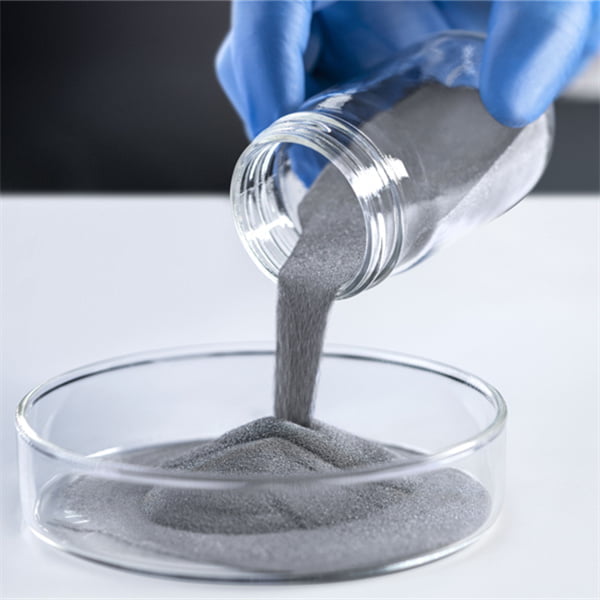
자주 묻는 질문
가스 분무와 물 분무의 주요 차이점은 무엇인가요?
가스 분무는 불활성 가스 분사만을 사용하여 용융 금속을 분말로 분해하는 반면, 물 분무는 가스 분사와 상호 작용하는 물 스프레이를 사용하여 냉각 속도가 빠르지만 분말이 불규칙합니다.
달성 가능한 가장 좁은 입자 크기 분포는 무엇인가요?
특수 노즐, 튜닝 및 분류기 단계를 통해 가스 분무 시 입자 크기 분포가 D10: 20μm, D50: 30μm, D90: 44μm까지 가능합니다. 더 엄격한 범위도 계속 개발 중입니다.
가스 분무 노즐은 얼마나 작아질 수 있나요?
시간당 1kg 미만의 배치 볼륨을 생산하기 위해 0.5mm 이하의 노즐 보어 크기가 개발되었습니다. 하지만 자유 낙하식 분말 분류는 20μm 크기 이하에서는 여전히 어려운 과제입니다.
파우더 배치 간 일관성에 영향을 미치는 요인은 무엇인가요?
조성, 청결도, 온도 프로파일, 가스 압력, 분무 조건, 분말 취급/보관 등을 제어하면 재현성을 높일 수 있습니다. 엄격한 공정 제어가 필수적입니다.
초기 질량 대비 일반적인 분말 수율은 얼마입니까?
일반적인 합금 및 크기 범위의 경우, 수율 백분율은 일반적으로 원하는 분포 폭과 허용 가능한 분율 아웃에 따라 50-85%에 걸쳐 있습니다. 분포가 미세할수록 수율이 낮아집니다.
공유
중국 칭다오에 본사를 둔 선도적인 적층 제조 솔루션 제공업체인 MET3DP Technology Co. 당사는 산업용 3D 프린팅 장비와 고성능 금속 분말을 전문으로 합니다.
관련 기사
Met3DP 소개
최근 업데이트
제품

3D 프린팅 및 적층 제조용 금속 분말
문의 정보
- 칭다오시, 산둥성, 중국
- [email protected]
- [email protected]
- +86 19116340731







